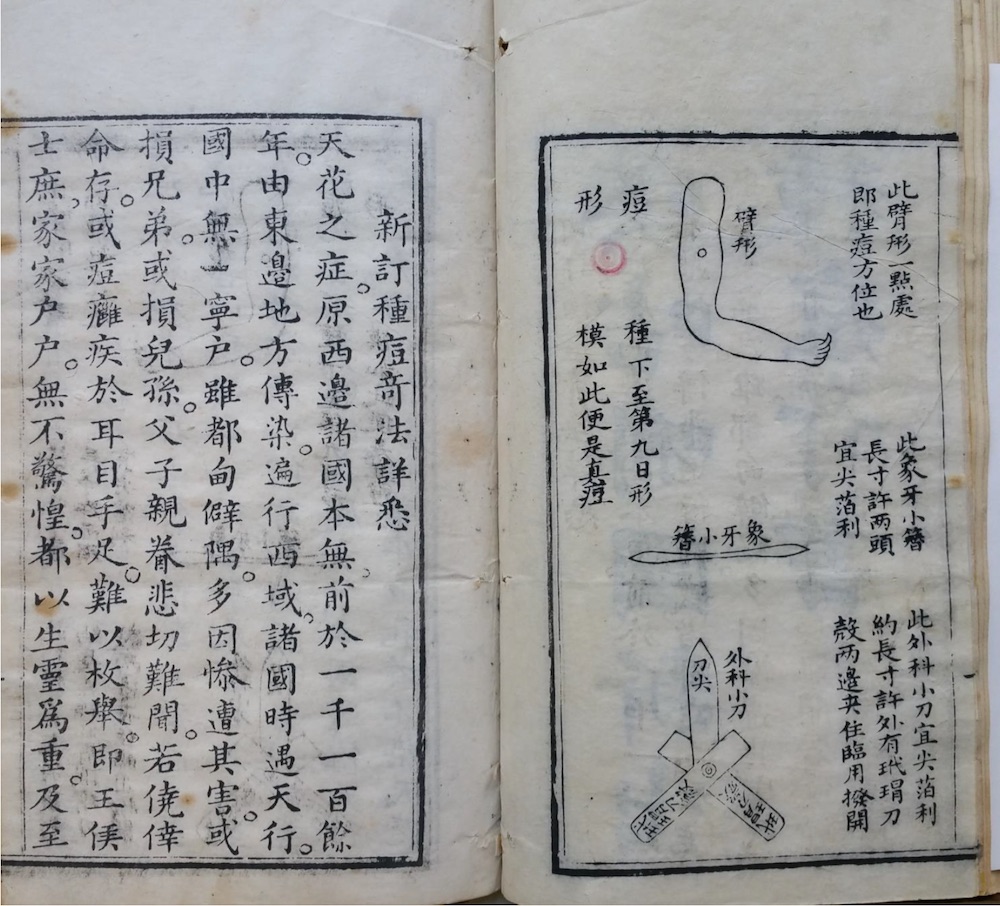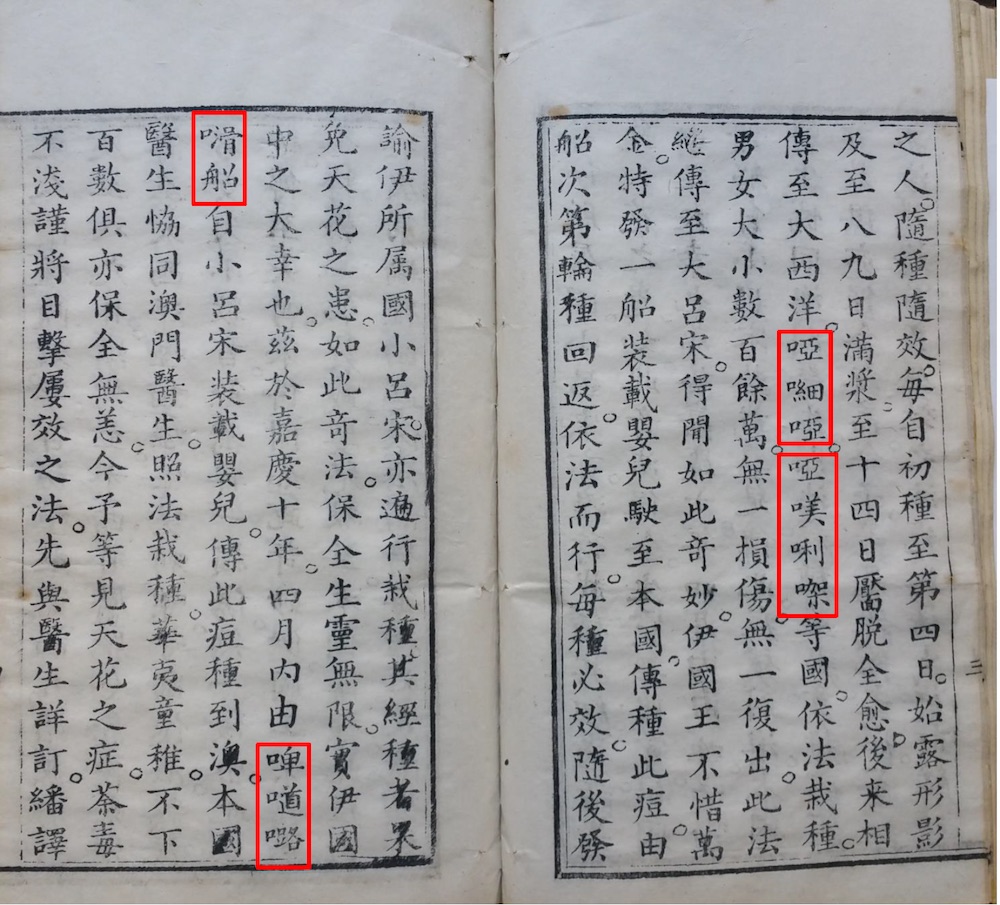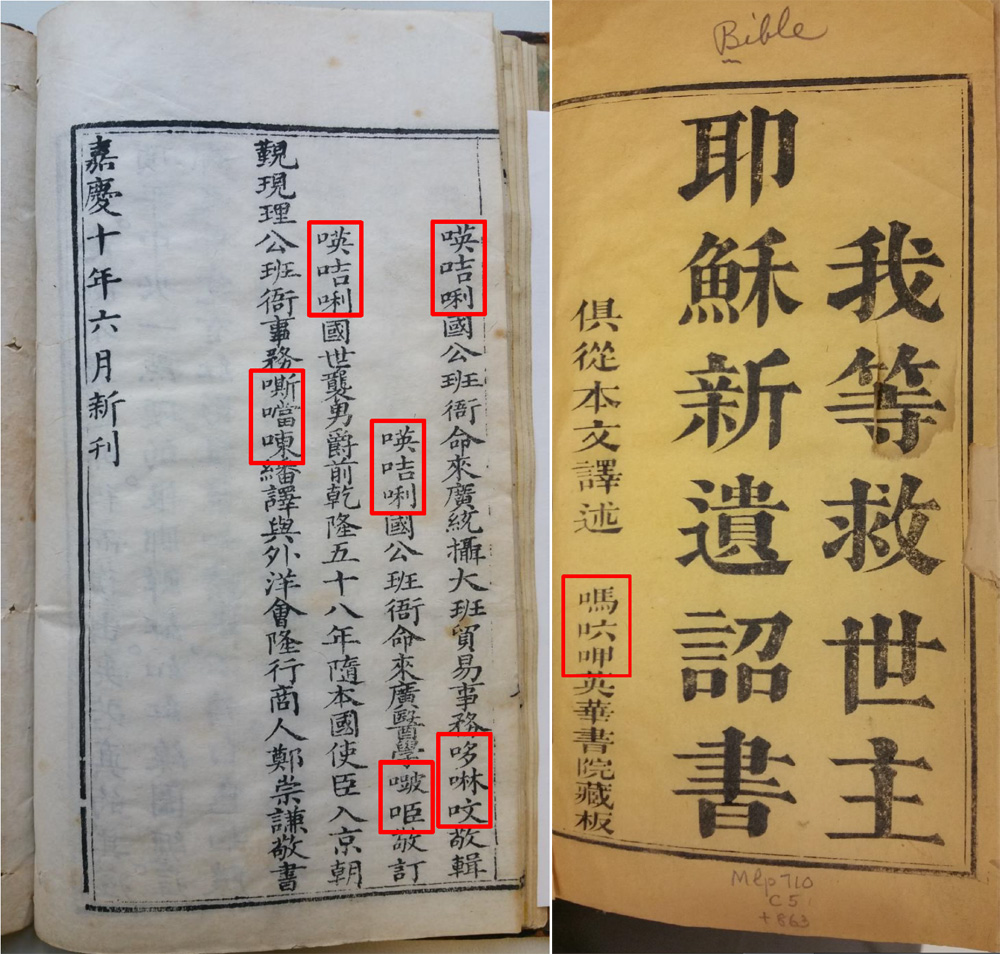Spelling with Chinese character(istic)s, pt. 2
« previous post | next post »
Michael Meng, China curator at the Yale University Library, discovered several rare books in Yale's Medical Historical Library that provide important evidence for the development of phoneticization of Chinese characters in the transcription of country names and personal names of foreigners.
The books are by Thomas Staunton (1781-1859), son of George Staunton (1737-1801), who was George Macartney's (1737-1806) right-hand man on the famous first British diplomatic mission to China, referred to as the Macartney Embassy or Macartney Mission (1792-1794).
Thomas was only 12 years old in 1792 when he accompanied his father on the Macartney Mission. Already before the trip, Thomas had begun to learn Chinese with the teacher, writer, and statesman, Sir John Barrow, 1st Baronet (1764-1848), so he was made Page to Lord Macartney on the Mission, during which period he continued to make progress in the study of Chinese. In 1797, he enrolled for two terms at Trinity College, Cambridge.
Important additional information about early British Chinese language specialists may be found in this post: "Character amnesia in 1793-1794" (4/24/14).
In 1798, Thomas was appointed as a writer in the British East India Company's factory at Canton (now called Guangzhou) and later became its chief. All of this enabled him to become increasingly proficient in Chinese.
In 1805 Thomas translated a work of Dr George Pearson into Chinese, thereby introducing vaccination into China. Five years later he published a translation of a significant part of the Chinese legal code.
[from the Wikipedia article]
Here are some pages from the books to which reference was made at the beginning of this post (click to embiggen).




These books offer interesting evidence of putting the mouth radical before country names and personal names of foreigners ca. 1800. Here are some of the names inside of the red rectangles in the photographs that are rendered in this fashion (imagine that each of the characters is prefixed with a little mouth radical):
Mǎliùjiǎ 马六甲 ("Malacca")
Yīngjílì 英吉利 ("English")
Yàxìyà 亞細亞 ("Asia")
Yàměilìjiā 亞美利架 ("America")
I omit many of the other transcriptions inside of the red rectangles, but I thought it would be interesting to show how Staunton transcribed his own surname (the last item on the final page among these photographs):
Sīdāngdōng 斯當東 (all first tones!)
The title of the book introducing vaccination to China is:
Yīngjílìguó xīn chū zhòngdòu qíshū 英吉利國新出種痘奇書
(lit., "English Country Newly Published Marvelous Book on Planting Smallpox", i.e., "Newly Published Extraordinary Book on Smallpox Vaccination from England")
The practice of affixing mouth radicals to Chinese characters to indicate that they are being used for transcriptional purposes began already with the writing down of the sacred sounds of Sanskrit. In the 15th century, it was being used for the transcription of the Sanskritic Buddho-Daoist deity name Nézhā / Nuózhà 哪吒 ("Naṭa[kuvera]). In this case, the mouth radicals were added later to a transcriptional name that had been coined centuries before.
One of the most common uses of mouth radicals to designate transcriptional syllables — though it is by no means de rigueur — is for dhāraṇī ("ritual speech") and mantra ("a sacred utterance, a numinous sound, a syllable, word or phonemes, or group of words in Sanskrit believed by practitioners to have psychological and spiritual powers. A mantra may or may not have syntactic structure or literal meaning."), especially as employed in esoteric Buddhism. This goes back essentially to the beginning of Buddhism in China as an organized body of doctrine, practice, and systematic translation of Indian texts into Chinese. See:
Paul Harrison and W. South Coblin, "The Oldest Buddhist Incantation in Chinese? A Preliminary Study of the Chinese Transcriptions of the Mantra in the Druma-kinnara-rāja-paripṛcchā-sūtra", Sino-Platonic Papers, 222 (March, 2012), John R. McRae and Jan Nattier, eds., Buddhism Across Boundaries: The Interplay of Indian, Chinese, and Central Asian Source Materials, pp. 63-85.
Characters such as the following were already devised by around the 6th century for exclusive use in transcription:
luō 囉
mó 嚩
lí 口+梨
nǎ 哪
lǐ 哩
The addition of a mouth radical to Chinese characters used for the transcription of Cantonese syllables is still a very common practice today.
I personally think that it would be preferable to use some other mark than the mouth radical to indicate that a character is being used for transcriptional purposes, since there are hundreds of characters with mouth radicals that do have specific semantic content or emotive effect. Or a group of special characters could be created, one for each possible syllable in the language, that would be reserved solely for transcription, something like a large kana syllabary. Ideally, unlike luō 囉 and mó 嚩, they would have a minimum number of strokes. Still yet, a set of purely phonetic symbols could be employed; to a certain extent this is already happening with the Mandarin Phonetic Symbols (bopomofo, zhuyin fuhao) and the alphabet.
[h.t. Valerie Hansen; thanks to Ronald Davidson and Seishi Karashima]
Victor Mair said,
June 16, 2016 @ 5:30 pm
From Daniel Kane:
I have been scrounging around for some information on this, without much success. I checked in the 汉语大辞典 Hanyu Vol 3 p. 375. Of interest to the present discussion is a quotation from Lin Zexu (1785–1850), in which he writes 英吉利 ying-ji-li, all with 口, and 米利坚 (American) also all with 口. However, Lin also wrote 佛兰西 Fo-lan-xi 'Buddha-orchid-west' (French) without 口.
The Hanyu Dacidian also gives a Qing reference to 英夷 Ying-yi 'English barbarians'. Ying has 口 Rad. 30. There is also a quotation from Lu Xun, 英语 Yingyu 'English language' with a 口, which is not of relevance to the present question, except it is interesting to see it used so late.
I vaguely remember that the Qianlong emperor (1711-1799) referred to the Engish as 英吉利 Ying-ji-li. and perhaps these had the mouth radical. But I am not sure about this – just a vague impression. If someone wanted to check the original of his letter to George III it might be possible to verify it, but modern printed versions would only have the versions without 口。
Since writing the above, I remembered the character 里 with a 口 radical meaning [English] mile. The Hanyu Dacidian (Vol. 3 p. 359) says it is pronounced li3, or read yingli 'mile'. I guess this is one of the rare characters designed to be read with two or even three syllables (tushuguan 'library' with a 囗 (Rad. 31) surrounding a book, read tushuguan 'library' comes to mind. This one is even found in Simon's dictionary. I don't know if it ever caught on.
Victor Mair said,
June 16, 2016 @ 5:31 pm
From Dan Boucher, regarding the Druma-kinnara-rāja-paripṛcchā-sūtra:
Lokakṣema did translate that text. Paul Harrison has edited the Tibetan and the Taishō number is 624.
Victor Mair said,
June 16, 2016 @ 5:31 pm
From Jan Nattier:
I don't have a complete list of transcriptions in early translations (since my own compilations originally started just with terms used by Zhi Qian [fl. 222-252]). But I suppose one place to start would be with "Coblin's list" (which I'm sure you have right by your side!), which is nice (though very incomplete, details if you'd like). It's handy since it is in chronological order by translator.
About the Druma, though, that's a relatively easy one: yes (on the one hand), there is a version of the text attributed to Lokakṣema, T624. It is certainly old. But it either postdates Lokakṣema or it has been revised, given the degree to which it diverges from his "core texts" (the Aṣṭa, T224, and the Pratyutpanna, the [unrevised] parts of T418). So I put it in the category of "third-tier" texts in my Guide to the Earliest Chinese Buddhist Translations. (Appendix II of that book, by the way, is an index of Pāli and Sanskrit titles, which was designed as a short cut to finding things like this.
Eric said,
June 16, 2016 @ 7:37 pm
Would the pronunciation of the characters in Stanton's reading have sounded much like modern standard Mandarin?
Chris Button said,
June 16, 2016 @ 8:41 pm
While not specifically for transcriptional purposes, the use of the mouth radical as a "desemanticizing" element is actually attested as far back as the oracle-bone inscriptions where it marked a "jiajie" usage of a character.
Endymion Wilkinson said,
June 16, 2016 @ 9:50 pm
Fascinating posts and comments! The use of kou 口 flourished in the Qing, especially in Cantonese transcriptions of the names of foreign countries, but also for personal names, and novelties such as coffee or curry:
興呱 Hing Qua (Xinggua in Mandarin);
咖啡 kafei (from Dutch koffei (?); earliest appearance in Morrison (1819).
噶唎 [咖喱, 架厘] gali (curry), 1908.
Zhou Zhenhe 周振鹤 suggested that the nineteenth-century usage of kou 口 was derogatory (id. 2008. Yiyan shuyu 逸言殊语 [Anecdotes and unusual phrases]. Shanghai renmin, 10–11). The practice continues today (but not in a pejorative sense), especially in the formation of Cantonese characters in Hong Kong.
The late nineteenth century fusion characters, most using the mouth (and one the stone signific), were borrowed from Japan to indicate mainly English measures, such as inch or yard (cun 吋 or ma 碼). This is a different usage I think, because in these cases the kou 口 does not indicate the transcription of a foreign sound but the foreign use of a Sino-Japanese character.
unekdoud said,
June 16, 2016 @ 11:45 pm
Notice the position of the 口 radicals on 亞 and 滑, flush with the upper left corner. Most of the other characters have 口 positioned far above the center line of the character too. I don't know if this used to be the position of the radical, but it looks to me that most of these fusion characters were not available as a single glyph to the printer, suggesting that they were either nonstandard or too uncommon.
flow said,
June 17, 2016 @ 3:08 am
@unekdoud good catch, but also, I'm afraid, a flawed theory, and too little data here.
The specimens shown above have clearly not been typeset but printed from hand-cut woodblocks. That process involved a scribe who would write the text with brush and ink on sheets of fine, translucent paper; those sheets were then pasted upside-down onto the flat blocks, after which another craftsman would carve out the material around them, leaving the printing parts stand out in profile. Hence, arbitrary characters can and have been printed, older books being full with nonstandard character forms, used as the original text had them, selected at the scribe's whim, or as ordered by the ordering party (cf the Kangxi dictionary where virtually each and every character had to appear in exactly the form as ordered by the dictionary commission).
Of course, it is still possible that a given scribe or woodcutter would produce a less than formidable result when encountering a character form that was novel to them, and when you look at the enlarged scans, all the characters that have the mouth radical to the left do look a *tad* tortured. Then again, there are indeed a very few other characters that look slightly awkward to me, too (a 20th c foreigner, to be sure).
But: whether the positioning of the mouth radical is due to the scribe's or cutter's style of writing, or was done on purpose to signify the special role of that component—we can not say from the pages given. I couldn't find any case of the mouth radical to the left of a character except in those that were used phonetically. Is it possible to get more scans?
liuyao said,
June 17, 2016 @ 6:31 am
To check the transliteration of England and other countries in the Qianlong era, there's the official 皇清職貢圖, which has a woodblock printed version (included in the Siku Quanshu) as well as an elaborate, color painted long scroll. I couldn't find the full version of the latter, but segments of it are made available by Taiwan's Palace Museum. See http://theme.npm.edu.tw/exh104/langshining/italy/ch/page-5.html
No mouth radicals for 英吉利.
liuyao said,
June 17, 2016 @ 6:31 am
Sorry, the link should be this: http://theme.npm.edu.tw/exh104/langshining/italy/en/selectionZoom/img1_7_3.html
Jichang Lulu said,
June 17, 2016 @ 3:02 pm
One interesting thing about these transcriptions is what they can reveal about the topolects they might have entered Chinese through. The 吉 jí in 英吉利 makes sense in an early Mandarin context, where it had a velar initial g-, but not in e.g. Cantonese, where the character is pronounced gat1.
Perhaps 马六甲 Mǎliùjiǎ for 'Malacca' works best in Minnan. As a transcription of the Malay (or English) name, 六 has the wrong vowel in Mandarin, and 甲 the wrong final -p. I wonder when the name began to be used in Chinese and where it came from.
A more Mandarin-friendly name for Malacca, 满剌加 Mǎnlájiā, occurs in the Ming Shi 明史.
WSM said,
June 17, 2016 @ 7:11 pm
Some other interesting data points: the island of "Java", now written as 瓜哇, appears in early (~1750s) manuscripts of 红楼梦 as 瓜窪; in Chapter 63 there's a reference to France as as 福朗思牙. Additionally, "汪恰"洋煙 (Chapter 52) may be a very early reference to "Virginia" tobacco!
Doc Rock said,
June 17, 2016 @ 9:40 pm
Wow, I don't think I've seen Endymion Wilkinson since the mid-1960's at Princeton or Jan Nattier since my days on faculty in Uralic and Altaic Studies at Indiana a few years later! I just wanted to add that reading these early characters in Mandarin loses some of the phonetic relevance of the character selections for the transcriptions and a more southerly voice might be instructive. Forgive a poor Koreanist [and non-linguist] for this interjection. Cheers Ed Rockstein
WSM said,
June 18, 2016 @ 1:49 pm
have to correct my earlier post: it looks much more like that 汪恰 is an early transliteration for the French word "Ange", i.e. "Angel".
unekdoud said,
June 20, 2016 @ 12:49 pm
@WSM I was going to correct you by saying that the character used in "Java" is 爪 rather than 瓜, but some quick googling shows that 瓜 is still used sometimes on the internet.
Some ghit counts: "爪哇" 491000 "爪洼" 42000 "瓜哇" 40600 "瓜窪" 13300. Google includes results with 洼 into searches for 窪 and vice versa, so their counts are the same.
In any of these names, the first character never picks up a 口 radical even though 呱 is commonly used in Mandarin for onomatopeia.
WSM said,
June 20, 2016 @ 4:06 pm
@unekdoud – whoops, good catch; I misremembered. I guess zhua3/爪 makes more sense in any case :-)
Interesting to observe both variations also in the 四庫全書 as hosted by kanripo.org, which at least makes me feel better about the confusion (not the first time, with this particular character).